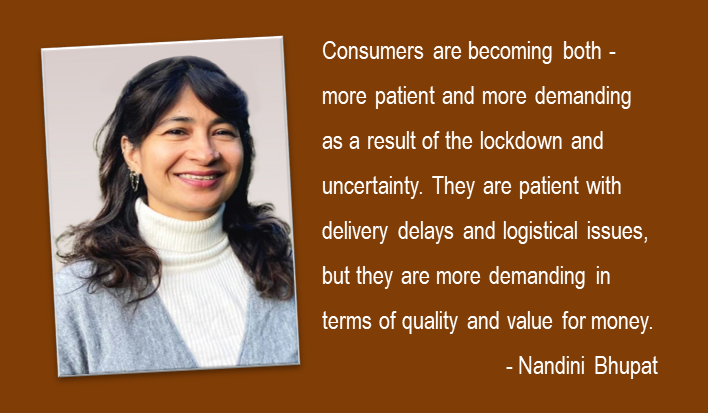Usually, change is difficult. Unless forced to, most people will not change long-held opinions, habits, or preferences and that is exactly what has transpired over the last few months. The pandemic resulted in widespread social isolation and shelter-in-place conventions, altering stock, sales and supply chains — and, as a result, consumer purchasing patterns. Brands and retailers hurried to make the most of new technology.
The consumer went through a phase of deprivation of basic needs, and experienced new products which were most accessible during the period of lockdowns and curfews. This has led to an altered lifestyle and give rise to new attitudes and perspectives to all aspects of life be it about consumerism or savings or ownership patterns. Brands need to understand these changes in mindset, psyche, behavior to be able to cater to and connect with the post-pandemic consumer.
Here are some of the critical ways the pandemic has affected consumer preferences:
Affinity vs. Accessibility
Consumers discovered that the brands they loved, favoured, or were already accustomed to were frequently out of stock be it; groceries, house cleaning goods and other staples of everyday life and they ultimately began using brands that were on the shelf. In many situations, the new brands have proven to have clicked with consumers successfully.
Over 35% of consumers stated they would continue to buy the new products that they began using, and used throughout the crisis.
Consumers who purchased online for the first time or more extensively during the pandemic lockdown prefer to stick to online purchase even after the lockdown. Over 80% of consumers prefer digital shopping over physical visits to the store. For example, people are usually not inclined towards frozen, or ready to eat food but on the contrary, they have been flying off the shelves, whether from a local retail store or online. One of the most demanded products was instant noodles, which saw revenue growth of 10% in the last quarter. There has been a significant rise by 25-30% in its demand in comparison to pre-COVID times.
Vocal for Local
During the pandemic lockdown, consumers began relying on local communities and local produce due to logistic and other limitations. Consumers may choose to buy things created locally, and from community businesses, as a result of rising movement in its favour to support the local manufacturer or sellers.
Brands will need to pay closer attention to customer sentiment as they make production and marketing decisions in the coming months. To reach out to more local and micro-communities, brands would need to re-look their whole supply networks and marketing value chains, rather than focusing on just one or two aspects of it. As they say, People don’t buy for logical reasons, they buy for emotional reasons. One of the examples is how Dabur being a 135 years old brand launched new campaigns under Vocal for Local schemes and promoted their Ayurvedic and Natural healthcare products.
Safety and Comfort
In recent months, one of the top issues on consumers’ minds has been and continues to be safety. As a safety measure, the consumer prefers to shop from a local store, making a purchase online, opting for contact-less delivery and so on are some of the top changing behavioral aspects of consumers.
However, the consumer is willing to pay a bit more for a safer environment or their comfort. 73% of people say that they are comfortable with additional cleaning and safety charges for their products/service delivery at the comfort of their home. Saloon services are a great example of how an additional minimum of Rs.100 was charged as a hygiene fee – be it for at home services, or in-store. Customers were pre-informed of these additional charges, and also comfortable in paying this incremental charges for the value add they received.
Health is Wealth
To say that COVID-19 has pushed through changes to how people look at their lives and live it would be an understatement. Consumers are paying more attention to their health and are buying essentials or healthy products. The demand for hygiene products/wellness products has been on top of the consumer’s demand chart. As per a report by Businesswire, demand for fitness equipment grew by 170% during the lockdown. Work out from home has been the most trending and seen a surge in demand and brands today are leveraging this demand by adding trendy gadgets, or new styles of equipment to meet their customer’s requirements. Brands that have caught the pulse of the market and adapted with the change in demand by adding value to the existing products or are innovating with new products are growing. It is becoming increasingly important for companies to promote healthy lifestyles for their customers and staff, to pay attention to consumer concerns and to develop solutions to ensure consumer safety.
Patience and Awareness
Consumers are becoming both more patient and more demanding as a result of the lockdown and uncertainty. They are patient with delivery delays and logistical issues, but they are more demanding in terms of quality and value for money.
Consumers are becoming more aware of the brands they choose by paying closer attention to what they’re buying and are attempting to reduce waste, shop more cost-effectively and purchase more environmentally friendly products. EY future consumer index says 46% of consumers are now more paying attention to the brands they are choosing while 42% says, their product purchase has changed significantly.
Brands will need to be more product-specific, show more empathy and be socially responsible. Brands that can innovate and stand strong to be there for consumers through times of crisis, as well as meet their evolving requirements, will be successful today and in the future.
The views and opinions published here belong to the author and do not necessarily reflect the views and opinions of the publisher.



Be the first to comment on "Keeping up with the Consumer"